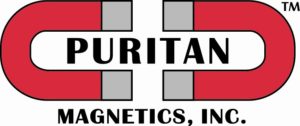AIR GAP: The distance between the north and south poles of a magnetic circuit. In conducting pull tests this is the distance between the working surface of the magnet and the testing apparatus.
ANISOTROPIC: (oriented) A material that has a preferred direction of magnetic orientation which produces superior magnetic characteristics through a particular axis.
COERCIVE FORCE, Hc: The intensity of a magnetic field required to reduce to zero the residual magnetism of a substance.
CURIE TEMPERATURE: The temperature that a magnetic substance loses its magnetic properties.
DEMAGNETIZING FORCE: A magnetized force applied in a direction that reduces the field in a magnetized material.
FLUX: Another term for the magnetic field.
GAUSS: The unit of magnetic induction or magnetic flux density used to measure magnetic field strength. (lines of magnetic flux per square centimeter).
GAUSSMETER: An instrument used to measure the intensity of a magnetic field.
GRADIENT: Indicates the change in magnetic strength between points measured at different distances perpendicular to the magnetic field.
INTRINSIC COERCIVE FORCE, Hci: Measurement of magnetic materials inherent ability to resist self demagnetization.
ISOTROPIC: (non-oriented) A material with no preferred direction of orientation resulting in the same magnetic characteristics through any axis.
MAGNET: A material that has the property, either natural or induced, of attracting iron or steel.
MAGNETIC FIELD: The space around a magnet in which the magnetic force can be detected.
MAGNETIC FLUX: The total magnetic induction across or through a specified area.
MAGNETIC INDUCTION, B: The production of magnetic properties in a magnetizable substance when placed in a magnetic field.
MAGNETIC LINES OF FORCE: A series of invisible lines passing from one pole to another of a magnet, which taken together form the magnetic field.
MAGNETIC ORIENTATION: Determines the magnetic polarity and position of one magnet pole to the other.
MAGNETIC SATURATION: The maximum amount of magnetic energy that can be absorbed by a magnetic substance.
MAXIMUM ENERGY PRODUCT, BH max: The point on the BH curve where the product of B and H is a maximum and the required volume of magnet material required to project a given energy into its surroundings is a minimum. (MGOe)
MAXIMUM OPERATING TEMPERATURE: The maximum temperature a magnet can withstand without significant long range instability or structural changes.
MGO: Mega Gauss Oersted.
NORTH POLE: The pole of a magnet that when freely suspended would point to the north magnetic pole of the earth.
OERSTED: The unit of magnetic intensity in the cgs ( centimeter-gram-second ) system that
describes magnetic force.
POLE PIECES: Steel plates attached to the north and south poles of a magnet which direct the lines of flux and can control the gradient of the magnetic field.
PULL TEST: A test of holding value or breakaway force and reachout, usually conducted with a flat ferrous plate or ferrous sphere and a spring scale.
REACH OUT: The distance in which a magnetic field will extend from the magnet source.
RESIDUAL MAGNETISM: Small amounts of magnetism that remain in a material after being exposed to magnetic force.
